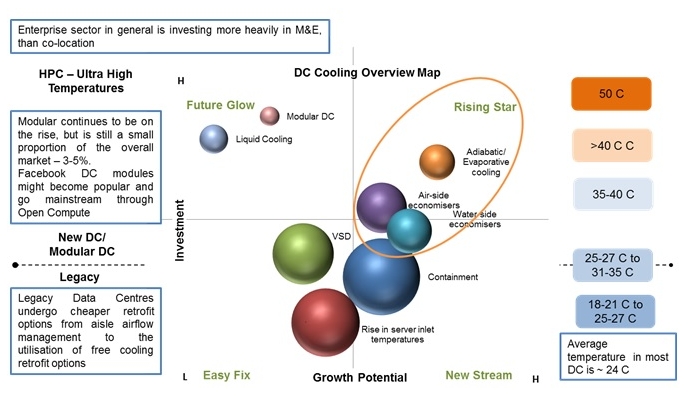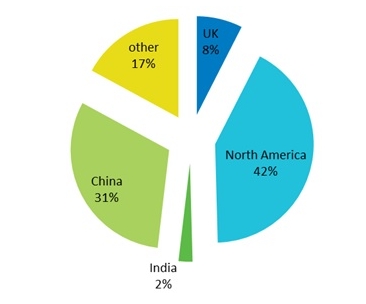Large hyper data centres demand for precision cooling
In August 2015, a market study from BSRIA showed that large hyper data centres are changing the market for precision cooling and that over the next five to 10 years the use of traditional computer room air-conditioning (CRAC) units is expected to drop dramatically as data centres opt for a combination of free cooling, liquid cooling and chilled-water cooling.
Hyper scale data centres such as those of Apple, Google, Facebook, Amazon, AWS and Yahoo! are very open to deploying “new” technologies, for example: modular, outdoor AHUs (air handling units) / evaporative cooling. This has driven a lot of change and enabled traditional air conditioning manufacturers like McQuay, Trane, Carrier, JCI, Daikin and others to participate in the data centre cooling market. Data centres in general are evolving rapidly. The standard design that was common in the last two decades is giving way to more flexible configurations that more closely match the sophisticated needs of more discerning, better informed customers.
Lone Hansen, WMI Manager – I.T. Cable Group, said: “Most of the large hyper-scale (American) data centres have a centralised team that will develop the specification with regards to IT equipment and networks, cooling and power. The specification will typically be rolled out globally and include several (often three to four) approved suppliers in each product category. A global footprint is an important part of the selection criteria. Most value multiple source relationships as opposed to single source relationships. Some of the products are sourced direct from the suppliers to reduce the cost while others are bought through distribution.”
Figure 1: Cooling technologies in data centres.
The figure above illustrates some of the new potential technologies and their positioning in terms of typical application and temperature operating range.
Data centre capacity is growing with the increasing number of IP connections, increasing traffic and need for storage. The precision cooling products installed in data centres are estimated at US$1.9 bn covering the 10 largest markets worldwide in 2014 and these markets are expected to show healthy growth up to 2017.
Figure 2: Data centre cooling by country, value, 2014.
The largest market is North America, accounting for around 40 per cent of the global data centre cooling market. China accounts for just under a third and the UK eight per cent. Other countries include Russia, Germany, France, Australia and Brazil, of which Germany is by far the largest, accounting alone for six per cent of the global market.
The US$1.9 bn does not include precision cooling products installed in non-IT sectors such as healthcare and laboratories, manufacturing, industrial, semi-conductors, education (close control applications in universities and school laboratories). Though smaller than the data centre market, this market is nevertheless substantial and its dimensions are also estimated in the study.
--BSRIA.
[edit] Related articles on Designing Buildings Wiki
- Air conditioning.
- BSRIA.
- Building management system.
- Building services.
- Colocation centre.
- Convergence and big data, The impact on structured cabling.
- Data centres.
- Data centre cooling.
- RenewIT tool.
- Uninterruptible power supply.
[edit] External references
Featured articles and news
Government consultations for the summer of 2025
A year of Labour, past and present consultations on the environment, the built environment, training and tax.
CMA competitiveness probe of major housing developers
100 million affordable housing contributions committed with further consultation published.
Homes England supports Greencore Homes
42 new build affordable sustainable homes in Oxfordshire.
Zero carbon social housing: unlocking brownfield potential
Seven ZEDpod strategies for brownfield housing success.
CIOB report; a blueprint for SDGs and the built environment
Pairing the Sustainable Development Goals with projects.
Types, tests, standards and fires relating to external cladding
Brief descriptions with an extensive list of fires for review.
Latest Build UK Building Safety Regime explainer published
Key elements in one short, now updated document.
UKGBC launch the UK Climate Resilience Roadmap
First guidance of its kind on direct climate impacts for the built environment and how it can adapt.
CLC Health, Safety and Wellbeing Strategy 2025
Launched by the Minister for Industry to look at fatalities on site, improving mental health and other issues.
One of the most impressive Victorian architects. Book review.
Common Assessment Standard now with building safety
New CAS update now includes mandatory building safety questions.
RTPI leader to become new CIOB Chief Executive Officer
Dr Victoria Hills MRTPI, FICE to take over after Caroline Gumble’s departure.
Social and affordable housing, a long term plan for delivery
The “Delivering a Decade of Renewal for Social and Affordable Housing” strategy sets out future path.
A change to adoptive architecture
Effects of global weather warming on architectural detailing, material choice and human interaction.
The proposed publicly owned and backed subsidiary of Homes England, to facilitate new homes.
How big is the problem and what can we do to mitigate the effects?
Overheating guidance and tools for building designers
A number of cool guides to help with the heat.
The UK's Modern Industrial Strategy: A 10 year plan
Previous consultation criticism, current key elements and general support with some persisting reservations.
Building Safety Regulator reforms
New roles, new staff and a new fast track service pave the way for a single construction regulator.



























